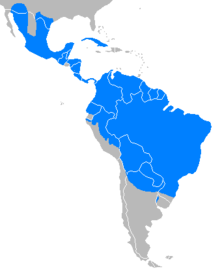Collared peccary
| Collared peccary | |
|---|---|

| |
| Scientific classification | |
| Kingdom: | |
| Phylum: | |
| Class: | |
| Order: | |
| Family: | |
| Genus: | |
| Species: | P. tajacu
|
| Binomial name | |
| Pecari tajacu | |

| |
| Synonyms | |
|
Tayassu tajacu | |
The collared peccary (Pecari tajacu) is a species of mammal in the family Tayassuidae that is found in North, Central, and South America. They are commonly referred to as javelina, saíno or báquiro, although these terms are also used to describe other species in the family. The species is also known as the musk hog and Mexican hog. In Trinidad, it is colloquially known as quenk.
Although somewhat related to the pigs and frequently referred to as one, this species and the other peccaries are no longer classified in the pig family, Suidae.

Description
Size
The collared peccary stands around 0.5 meters (20-24 inches) tall at the shoulder and it is about 1-1.5 meters (40-60 inches) long. It weighs between 16 and 27 kilograms (35 and 60 lbs).[2]
Range and habitat
The collared peccary is a widespread creature that can be found throughout much of the tropical and subtropical Americas, ranging from the Southwestern United States to northern Argentina in South America. The only Caribbean island it is native to, however, is Trinidad, although introduced populations exist in Cuba. It inhabits deserts and xeric shrublands, tropical and subtropical grasslands, savannas, and shrublands, flooded grasslands and savannas, tropical and subtropical dry broadleaf forests, and several other habitats, as well. In addition, it is well adapted to habitats shared by humans, merely requiring sufficient cover; they can be found in cities and agricultural land throughout their range, where they will add human garden plants to their menu. Notable populations are known to exist in the suburbs of Phoenix and Tucson, Arizona.[3][4]
Diet
Collared peccaries normally feed on fruits, roots, tubers, palm nuts, grasses, invertebrates and small vertebrates. In areas inhabited by humans, they will also consume cultivated crops and ornamental plants, such as tulip bulbs.[3][4]
Behavior
Collared peccaries are diurnal creatures that live in groups of one to 20 individuals, averaging between six and 9 members. They frequently sleep at night in burrows, often under the roots of trees.
Although they usually ignore humans, they will react if they feel threatened. They defend themselves with their long tusks, which can sharpen themselves whenever their mouths open or close. A collared peccary will also release a strong musk if it is alarmed.
References
- ^ Template:IUCN2011.2 Database entry includes a brief justification of why this species is of least concern.
- ^ "Collared Peccary: Javelina ~ Tayaussa ~ Musk Hog". Digital West Media Inc. Retrieved 8 January 2012.
- ^ a b Friederici, Peter (1998). "Winners and Losers". National Wildlife Magazine. 36 (5). National Wildlife Federation.
{{cite journal}}: Unknown parameter|month=ignored (help) - ^ a b Sowls, Lyle K. (1997). Javelinas and Other Peccaries: Their Biology, Management, and Use (2 ed.). Texas A&M University Press. pp. 61–68. ISBN 978-0-89096-717-1.

